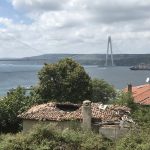Sarayburnu must be one of the world’s most familiar skylines – a promontory jutting out where the Golden Horn flows into the Bosphorus and the Sea of Marmara which is lined with the great buildings of the Byzantine and Ottoman supremacy: Ayasofya/Hagia Sophia, Topkapı Palace and the Sultanahmet Cami/Blue Mosque. The buildings are bedded down amid greenery with the remnants of the Sea Walls that used to protect the city surviving in stretches beneath them. And right at the tip stands the very first statue of Atatürk to have been erected in the country, asserting the ultimate supremacy of the Turkish Republic.
High up on a marble pedestal, the bronze statue of Atatürk was designed by the Austrian Heinrick Krippel (1883-1945) in 1926. It shows the country’s first president gazing across the Bosphorus towards Kadıköy. In 2024 slight remains of buildings associated with the Romano-Byzantine Phosphorion harbour discovered during construction work for the Marmaray were re-erected to the right of the Atatürk statue alongside a new cafe offering a panoramic view of the confluence of the three stretches of water surrounding İstanbul. Some were clearly public buildings although their precise purpose has not yet been established.
Sepetçiler Kasrı
Across the road and behind the statue stands the Söğükçeşme Kapı (Cold Fountain Gate) entrance into lovely Gülhane Park. If instead of going into it you turn right and walk away from Seraglio Point along the busy main road to Sirkeci you will pass an elegant stone building called the Sepetçiler Kasrı (Basketmakers Pavilion) which stands on a site probably occupied since the fifth century. It was rebuilt under the aegis of the chief architect, Davut Ağa, a pupil of Mimar Sinan, in the late 16th century, then remodelled in in the 1640s for Sultan İbrahim the Mad. Used as a boathouse with rooms above it, the kasrı acted as the launchpad whenever the sultans wanted to take a boat trip. By the 20th century it had fallen into ruin so what you see now is mainly the work of a 1980 restoration. After an unhappy period in which it became first the International Press Centre and then a nightclub, It now serves as the HQ of Yeşilay, the Turkish temperance organisation.
The Sepetçiler Kasrı was once one of four waterside pavilions in the area all designed by Davut Ağa. Continuing towards Sirkeci you’ll pass the site of the lovely Yalı (Cebeciler) Kösk (Armourers’ Pavilion), originally built in the early Ottoman period but rebuilt at the end of the 16th century by Davut Ağa. Used for official ceremonies and entertainment for the sultans’ families, the köşk was demolished in 1869 during the building of the railway line to Edirne. It survives in writers’ and artists’ accounts as an open-sided, domed pleasure-house, entirely lost to modernisation.If instead you turn left from the statue of Atatürk you will be able to follow a waterside promenade that parallels busy Kennedy Caddesi and from which you will be able to view the remains of the old Sea Walls (although in 2024 long stretches were hidden behind hoardings as restoration work progressed). Here it’s still possible to see the remains of the cross-shaped İncili (Pearl) Köşk which was constructed between the Degirmen and Ahır gates during 1589-1591 under the oversight of Davut Ağa. It was commissioned by Koca Sinan Paşa who wanted to curry favour with Sultan Murad III after the abrupt dismissal of several other grand viziers. A place for relaxation, it was constructed above an ayazma (sacred spring) called Tu Sotiros by the Greeks and just behind it was a square where cirit (a form of polo) was played. Supposedly the walls were lined with İznik tiles and pearls hung down from the ceiling – perhaps the closest thing we have to it now is the Hunkar Kasrı attached to the Yeni Cami at Eminönü which is only sporadically open to the public. It was here that Sultan Murad III died and here that an organ gifted by Elizabeth I to Mehmed III was placed. Hard though it is to imagine it, before the Kennedy Caddesi was constructed on reclaimed land there was actually a beach in front of the köşk where pilgrims visiting the ayazma would sometimes partially bury themselves in hope of a cure.
Despite several restorations, the İncili Köşk had fallen into disrepair by the 19th century and was never used again after the sultans moved to Dolmabahçe Palace. In 1872 all but the base and foundations were levelled as the railway line was expanded.
Transport info
Sarayburnu is a short walk away from Sirkeci train and Marmaray station although along a very busy main road. Nicer is to walk through Gülhane Park (accessible by the T1 tram to Gülhane) and exit close to Sarayburnu itself.


